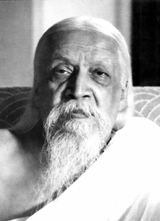Integral Health
The metaphysical basis for Integral Health — Integral Manifestation
In the gestalt perspective, the whole is more than the sum of its parts. When the parts, though appearing discrete and separate, have an underlying commonality, an integrated perspective appears. If however, the parts not only reflect the whole but the whole itself is present in essence in each part and if each part is identified with the whole, we can begin to appreciate what we mean by integralism.
Integralism is a complex phenomenon. The One does not become the Many at the strike of a gong, nor does the Infinite change into finite one morning. Rather they co-exist as different poises of an Integral Reality. In Chapter V of The Life Divine, Sri Aurobindo characterises the existential aspect of Reality as Integral Manifestation. Reality is conceived to be One, whether manifest or unmanifest, and in the various forms and processes of manifestation. Reality is perceived in essence as a Being (or Non-being) while whatever has manifested within the limits of space and time have been termed as Becoming.
Some view ‘Being’ to be ‘Real’ and ‘Becoming’ to be illusory, ephemeral, existing only in subjective perception. Sri Aurobindo views both ‘Being’ and ‘Becoming’ to co-exist simultaneously:
“Being and Becoming are the single One. The One does not become the Many, but the One is for ever the Many even as the Many are for ever the One….
This One can be all because it is no one in particular, it can be all-pervading and eternal in its essence because it is not bound by Space or by Time. It is One but it is also multitudinous, its multitudes are the self-expression, not the denial, the abundance, not the division or fragmentation of its oneness. Each being of its multitudes seems to be a portion of the One… (1)”
This means that in each form of manifestation, the Infinite is present as a finite phenomenon of itself.
If this is true, then what we term the manifestation is not a haphazard phenomenon. If all that is manifested is simultaneously another poise of that which exceeds the manifestation, then obviously, such a manifestation must follow its own law, rhythm and harmony. Indeed the manifested worlds have their own laws and processes, which are so exact and precise that the human mind has been able to systematise knowledge. The world of Matter has given rise to the physical sciences, the world of Life has given rise to the biological sciences and the world of Mind has given rise to the cognitive, psycho-social and metaphysical disciplines. Likewise, Reality, which is experientially perceived as a Oneness in essence that pervades and surpasses all manifested forms must have its own laws and processes. This Oneness is perceived and conceptualised in mystical disciplines in terms of ‘Consciousness’.
Actually, it is Consciousness that is the great underlying fact of existence, which formulates different planes at different levels of a graded universe. Consciousness is essentially the same throughout but variable in status, condition and operation. When mystics use the term ‘consciousness’, they refer to the essence of the ‘Being’ but Sri Aurobindo explains that the same is also the essence of ‘Becoming’. Only, when the same consciousness that is self-absorbed in the Being becomes the basis of all that is self-expressed in the Becoming, it has to have certain unique characteristics. These are:
a. The ‘manifestation’ of different planes of existence follows an ‘evolutionary’ spiral in the matrix of consciousness itself. The evolutionary nisus starts from the ‘Inconscience’ and progresses towards the ‘Super-conscience’. Evolution however cannot proceed from nothing. It is possible only because in the Inconscience is hid the potential of the Superconscience, just as in the seed is hid the potential of the tree.
b. The manifestation of different and diverse planes and poises of consciousness shows that consciousness is pluri-dimensional in nature. “Brahman expresses Itself in many successive forms of consciousness, successive in their relation even if co-existent in being or coeval in Time, …(2).” Consciousness is not only manifested in different planes (Matter, Life, Mind) but also in different poises: Individual, Universal, and Transcendent.
c. The different planes, forms and poises of Consciousness are not discreet and scattered but all can be represented in each and the One Omnipresent Reality can be represented in all. Besides, any higher plane of consciousness does not reject the preceding planes but incorporates, upgrades and transmutes them. Thus Life does not reject Matter but the quality of Matter inherent in living systems is vastly different from that in inorganic matter. Likewise, Mind does not reject ‘Life involved in Matter’ but uplifts it so that the life of the highly mentalised human being is qualitatively superior to the life of an animal with a rudimentary mind. Again, the essence of the Omnipresent Reality, which is present in each plane and form of consciousness also progressively unfolds its potentials as the evolutionary nisus traverses the hierarchies of consciousness. That is why the same essence of Reality is termed differently at different planes of consciousness — in Matter it is the True Physical Being (Annomay Puruṣa) while at the plane of Life, it is the True Vital Being (Pranomay Puruṣa) and at the plane of Mind it is the True Mental Being (Manomay Puruṣa). It is the same in different poises — the ‘sameness’ or ‘oneness’ is indisputable but the capacity of unfolding of potentials gives a meaning to the ‘difference’ too.
d. The consequence of ‘Oneness’ expressed uniquely in different planes of the manifestation permits the ‘lowest’ to be ‘transmuted’ in terms of the highest and the highest to be ‘manifested’ in terms of the lowest. In other words, if the ‘individual’ can ‘universalise’ oneself and climb to the ‘transcendence’, the ‘Transcendence’ can also manifest in the ‘universal’ and the ‘individual’:
e. “For the World-Transcendent embraces the universe, is one with it and does not exclude it, even as the universe embraces the individual, is one with him and does not exclude him. The individual is a centre of the whole universal consciousness; the universe is a form and definition which is occupied by the entire immanence of the Formless and Indefinable (3).”
f. Thus the manifestation is by its nature integral.
When Sri Aurobindo uses the term ‘integral manifestation’, He acknowledges the complexity of the manifestation; accepts it as an expression of the Omnipresent Reality and not an illusion; describes the ‘pluri-dimensional’ nature of the manifestation; traces the evolutionary curve in the matrix of consciousness that formulates the grades of the manifestation; and forwards the capacity of ‘transformation’ of the lowest integers in manifestation in terms of the highest and pari-passu, the blossoming of the ‘highest’ in conditions of the lowest. In other words, the ‘superconscient’ can manifest in earthly life; the Transcendent can be expressed in terms of the Universal and Individual. Despite the complexity of what has been described, the entire manifestation culminates in an integral movement where the Infinite can be expressed in terms of the Finite and the Finite can be transformed in terms of the Infinite. In this scheme of things, the manifestation itself is integrally dynamic. That is why Sri Aurobindo describes the manifestation as an ‘integral manifestation’.
In the integral manifestation, the Absolute, the One, the Transcendent becomes the Many and each individual formation representing the Many can also transfigure itself through an evolution in consciousness, in terms of the Transcendent.
Practical implications
The concept of integralism has enormous significance in understanding human behaviour and issues in health and illness. Each piece of behaviour is not an isolated characteristic; each act of consciousness is not a single phenomenon. Psychoanalytic probing has shown how the unconscious influences behaviour. Truth is however very complex and if the unconscious influences behaviour, the cosmic consciousness and the Superconscious equally influence behaviour. The cosmic consciousness also contains influences existing from past eras, past-lives and occult forces — all of which can coalesce to bring about greater disharmonies to which a vulnerable subject can succumb. The Superconscious pulls us up from the downward gravitational influences of the Inconscience and its Saviour Grace helps us to sail through the adversities of life. Each piece of behaviour is not an isolated episode but an integer in an integral manifestation.
When a subject with cardiac pain presents himself at the hospital, the organ involved is one part of the whole. There has been the lifestyle of the subject which has contributed to the clinical picture today and cannot be kept out of consideration. There is the collective suggestion in the cosmic consciousness which identifies any chest complaint with the heart and the subject is not free from that influence. The roots of the disharmony can be traced to the subconscious and the Inconscience and these influences sustain the bodily disharmony. The body itself has emerged from the Inconscience and carries its stigma. There is the stress of performance at the office which cannot be underestimated. Such stress happens when the outer activity is not balanced by a poise of inner peace and harmony.
Finally, the presence of the Superconscient influences the subject to outgrow the disharmony and shift to a new level of harmony. An illness can be an opportunity to outgrow one’s limitations and evolve in consciousness. The Superconscious itself exerts its influence on the individual evolving along the evolutionary trajectory in consciousness. A simple cardiac pain is no longer an isolated event but an integer in a whole where all integers are not only connected but each exists in the other and the whole exists in each. It is not enough to direct remedial measures to the target organ alone. Rather, all dimensions of consciousness should be considered in the integral perspective. This is how the integral health practitioner acknowledges the integral manifestation.
References
1. Sri Aurobindo. Collected Works of Sri Aurobindo, Volume 12. Pondicherry: Sri Aurobindo Ashram Trust; 1997, p. 196.
2. Sri Aurobindo. Birth Centenary Library, Volume 18. Pondicherry: Sri Aurobindo Trust; 1970, p. 36.
3. Ibid., p. 37.
Share with us (Comments, contributions, opinions)
When reproducing this feature, please credit NAMAH, and give the byline. Please send us cuttings.





